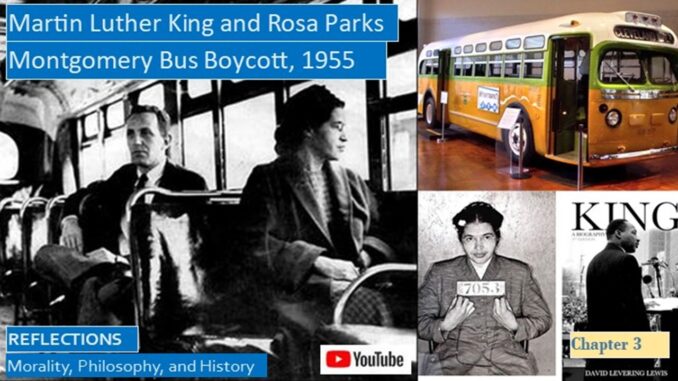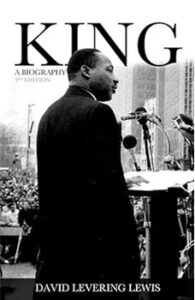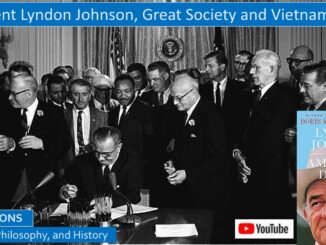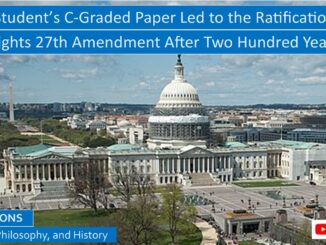
Today we are reflecting on the chapter in David Levering Lewis’ biography of Martin Luther King on the Montgomery Bus Boycott. We reflect on these questions:
Did Rosa Parks plan in advance to refuse to move to the back of the bus, to make way for white passengers?
How did Martin Luther King gain national prominence in the Montgomery Bus Boycott?
How did the leaders of the boycott respond to the violence and bombings of their houses and churches?
Why was the country receptive to civil rights reforms at the time of the 1955 Montgomery bus boycott?
David Levering Lewis prefaces this chapter of his biography of Martin Luther King with a quote from James Weldon Johnson: “Lift every voice and sing till earth and heaven ring, ring with the harmony of liberty.”
YouTube presentation for this video, with illustrations and more Amazon book links:
https://www.slideshare.net/slideshows/martin-luther-king-and-rosa-parks-montgomery-bus-boycott-lewis-biography-chapter-3/265363397
YouTube video for this blog: https://youtu.be/_TLt2fQqL4w
ROSA PARKS REFUSES TO MOVE TP THE BACK OF THE BUS
As a young minister graduating from a prestigious seminary, Martin Luther King was honored by his calling to be the minister of the renowned Dexter Avenue Baptist Church, a prestigious colored church in Atlanta, Georgia in early 1954. But in December 1955, during the busy Christmas season, an event that would change both the course of his life and American history occurred when a courageous, courteous, and unassuming black lady broke both the law and Southern etiquette by refusing to give up her seat to a white passenger and move to the back of the bus. The police were called, and they arrested Mrs Rosa Parks.
The biographer David Levering Lewis writes, “By her dignified bearing during her arrest and arraignment, and because of her impeccable reputation in the black community, Mrs Parks’ defiance compelled the city to charge her explicitly with the violation of the municipal ordinance governing racial accommodation on publicly owned vehicles, and not, as was usually the case, with the elastic offense of disorderly conduct.”
Had this protest been planned? Previously Rosa Parks had been employed as a secretary for the NAACP, she was now employed as a seamstress. The previous year the Supreme Court had handed down the Brown v Board of Education decision, which mandated the desegregation of public schools with all deliberate speed. Also, that year the black fourteen-year-old Emmitt Till was brutally tortured and murdered by grown white men.
The NAACP and a multiplicity of black civil rights organizations were challenging many of the Jim Crow segregation laws. Three other black ladies had previously defied the segregationist seats on the municipal buses. The Woman’s Political Council, formed by civic-minded black women when they were denied membership in the white League of Women Voters, had already negotiated with the local white businesses for the removal of separate drinking fountains for blacks and whites, and were strategizing a bus boycott.
Though her timing was, in hindsight, impeccable, this refusal of Rosa Parks to relinquish her seat to a white passenger was an impetuous decision of the moment. Although the officials of the NAACP arranged her bail, they were taken by surprise. What happened on that rainy December day was that Rosa Parks, tired from a long day at work, was sitting in the first row of the colored section of the bus. When the white section had filled up, the bus driver moved the black section signs back a row and told the four black passengers to move to the back of the bus to make room for more white passengers. Three black passengers moved to the back of the bus, but Rosa Parks instead moved to the window seat.
ORGANIZING THE YEAR-LONG MONTGOMERY BUS BOYCOTT
Both the NAACP and the Women’s Political Council quickly acted to fan the flames of the Rosa Parks incident. While driving home Rosa Parks after bailing her out of jail, attorney Fred Gray asked her if she was willing to be the “symbol to galvanize the black community,” and she assented. Then they asked the unknown Martin Luther King, who had previously turned down the presidency of the local NAACP chapter due to other commitments, if he wanted to be a part of the movement. He, too assented, after conferring with Reverend Ralph Abernathy of the Montgomery First Baptist Church. Martin was the educated pastor, while Abernathy’s preaching was charismatic. These leaders organized the boycott of the Montgomery municipal buses.
The bus boycott lasted from early December 1955 to late December 1956. The Montgomery Improvement Association, or MIA, was formed to coordinate the boycott. They elected Martin Luther King to lead the organization, perhaps they were impressed by his oratorical skills. This struggle captured the attention of both national and international media, through his oratorical skills Martin Luther King became a prominent mouthpiece of the Civil Rights movement.
Martin Luther King addressed a crowd of four thousand at the Holt Street Church, describing the injustices of the bus company and the abuses suffered by Rosa Parks. There he preached: “There comes a time when people get tired. We are here this evening to say to those who have mistreated us so long that we are tired, tired of being segregated and humiliated, tired of being kicked about by the brutal feet of oppression. We have no alternative but to protest. For many years we have shown amazing patience. We have sometimes given our white brothers the feeling that we liked the way we were being treated. But we come here tonight to be saved from that patience that makes us patient with anything less than freedom and justice.”
This boycott was not merely a boycott against seats on buses, it was a protest against the entire segregationist structure. In Montgomery, 50,000 blacks feared the intimidation of 70,000 white citizens. Two-thirds of colored residences lacked indoor flush toilets compared to five percent of white residences. The schools and parks of blacks were grossly inferior to those of whites. Only two thousand blacks, most of them officer workers, were registered to vote.
Lewis states that “Ralph Abernathy presented these demands of the boycott:
- Courteous treatment by bus drivers.
- First-come, first-serve seating arrangement, with blacks filling the rear and whites the front.
- Employment of black drivers on predominantly black routes.”
Note that strict equality was not demanded at this early stage of the struggle.
The blacks overwhelmingly supported the boycott, the day after it was announced there were very few blacks riding the buses. But how could they sustain the boycott? The initial strategy was for the black taxi drivers to offer rides for free to those blacks boycotting the buses, but this was impossible due to a municipal ordinance that prescribed a minimum fare for taxis, and breaking this law would cause them to lose their license and insurance. Instead, they organized a vast carpool that lasted throughout the boycott. One unanticipated benefit was that the affluent blacks became more acquainted with the problems confronting the less prosperous blacks, which strengthened racial solidarity.
VIOLENT OPPOSITION TO THE BOYCOTT, AND DYNAMITE
Those who led the boycott faced firm opposition that sometimes became violent. In the newspaper Mayor Gayle announced, “It is time to be frank about this matter. The white people are firm in their convictions that they do not care whether the Negroes ever ride a city bus again if it means that the social fabric of our community is to be destroyed so that Negroes will start riding the buses again.”
Martin Luther King had learned of a possible assassination plot. He proclaimed to a crowd: “’Let us keep moving with the faith that what we are doing is right, and with the even greater faith that God is with us in the struggle.’ He uttered these words before an MIA assembly moments after learning that his home had been dynamited and without certain knowledge of the welfare of his family.”
Miraculously, his family was unharmed. His baby was sleeping in the back of the house. His wife Coretta walked into the bedroom just before dynamite exploded on their porch, sending glass into the living room. Lewis writes, “As the din subsided, Corretta, in admirable control of herself, answered the telephone. ‘Yes, I did it,’ said a woman’s nasal voice, ‘and I’m just sorry I didn’t kill all you bastards.’”
Returning home, Martin had to push his way through a mob of more than three hundred angry blacks gathered at his porch, many of them armed, to check whether his family had been harmed. Lewis recounts that Martin, addressing the crowd, “asked for quiet: ‘We believe in law and order. Don’t get panicky. Don’t do anything at all. Don’t get your weapons. He who lives by the sword will perish by the sword. Remember, that is what God said. We are not advocating violence. We want to love our enemies. We must love our white brothers no matter what they do to us.’ The crowd dispersed and the crisis passed.”
There was other violence, both official and unofficial. Police threatened to issue tickets to crowds of blacks waiting for carpool vehicles for vagrancy and hitchhiking. White employers threatened to fire their domestic servants and employees. Two other houses of black activists were bombed. Martin Luther King himself was arrested for speeding; he was going 30 MPH in a 25 MPH zone.
The bus boycott continued. Financial donations flowed in from all over the world, the United Auto Workers sent a big check. The donations were welcome, their monthly expenses were five thousand dollars. In January alone they bought fifteen station wagons for the carpool. The MIA emphasized its strategy of non-violence. Martin Luther King gained prominence and was invited for speaking engagements at Fisk University and elsewhere.
Why did the Montgomery bus boycott command both national and international attention? World War II had ended only a decade before, everyone remembered how Hitler hated both Jews and blacks. In fact, the Deep South segregation laws were used as precedent to enact the Nazi antisemitic Race Laws. Oppressed nationalities were declaring their independence with American encouragement, we reflected on the related Pan-African movement in our reflections on WEB Du Bois. Later, in his Letters from a Birmingham Jail, Martin Luther King compared the lynchings of blacks in the Jim Crow era to the Nazi holocaust of the Jews. In addition, American officials were embarrassed by the segregationist treatment of the black diplomats of these newly independent nations in Washington DC, Maryland, and Virginia.
How the Racist Jim Crow Laws Served as Precedent for the Nazi Nuremberg Race Laws
http://www.seekingvirtueandwisdom.com/how-the-racist-jim-crow-laws-served-as-precedent-for-the-nazi-nuremberg-race-laws/
https://youtu.be/_td3jPGD5TI
Comparing MLK’s Letter from Birmingham Jail with Hannah Arendt’s Banality of Evil in Nazi Germany
http://www.seekingvirtueandwisdom.com/comparing-martin-luther-kings-letter-from-the-birmingham-jail-with-hannah-arendts-the-banality-of-evil/
https://youtu.be/PqFAUEXbi8k
WEB Du Bois and the NAACP, Continuing the Fight For Civil Rights
https://seekingvirtueandwisdom.com/web-du-bois-and-the-naacp-continuing-the-fight-for-civil-rights/
https://youtu.be/MNhkq69CIfo
Was WEB Du Bois a Communist? The Later Years of WEB Du Bois
https://seekingvirtueandwisdom.com/was-web-du-bois-a-communist-the-later-years-of-web-du-bois/
https://youtu.be/YwgrKvIjoc0
LEGAL STRUGGLES IN LOCAL COURTS AND SUPREME COURT
The Montgomery Bus Boycott was also a legal struggle. The boycott had a better chance of success because of the unanimous opinion of Brown v Board of Education, which signaled that the Supreme Court would support civil rights appeals. The Republican President Dwight D Eisenhower had appointed Chief Justice Earl Warren because of his conservative credentials rather than his judicial credentials. Earl Warren was Thomas Dewey’s running mate in the 1948 presidential election, so he surprised everyone with his pro-civil rights rulings. Since he was a politician, he knew that the Brown decision had to be a unanimous decision to send a clear message to the Deep South that Jim Crow segregation and discrimination would no longer be tolerated.
The local courts were adamantly opposed to the boycott. In February, the MIA leaders were indicted for “conspiracy to interfere with normal business.” This meant that Martin Luther King and the other MIA leaders were booked, fingerprinted, photographed, bonded, and released awaiting trial in March.
As expected, the MIA lost their case in local court, but they won in the court of public opinion, supported by a battery of competent defense attorneys. The parade of witnesses was embarrassing. As Lewis recalls, Mrs Stella Brooks’ “husband requested the return of his dime because the bus was too crowded,” he “was fatally shot by the police.” “Mrs Martha Walker’s blind husband’s leg was pinned by a bus door,” the bus driver dragged him for several blocks. There was other damaging testimony. Martin Luther King was called to the stand, he emphasized that they “avoid violence at all costs” in their protests. Eighty-nine defendants were found guilty, and the MIA appealed the decision.
In May “the suit contesting the state’s segregation laws” for public transportation “was heard in Montgomery.” The city argued that uncontrollable violence would result from invalidating these Jim Crow laws.
Lewis recounts, “Judge Rives posed the fundamental question: ‘Is it fair to command one man to surrender his constitutional rights to prevent another man from committing a crime?’” With only one dissent, these local judges declared the city’s bus ordinance unconstitutional, and the city appealed.
Then the city chose to enjoin the carpool itself as a public nuisance and an unlicensed private business. They were scheduled to appear before the same hostile judge that had ruled against them earlier. After the city’s attorneys were confidently arguing their case, the court declared a recess.
Lewis writes, “A reporter for the Associated Press handed Martin Luther King a note: ‘THE US Supreme Court today affirmed a decision of a special three-judge US District Court in declaring that Alabama’s state and local laws requiring segregation on buses unconstitutional. The Supreme Court acted without listening to any argument; it simply said the motion to affirm is granted and the judgment is affirmed.’”
Surprisingly, the local judge still ruled in favor of the city’s injunction, but in December a federal order desegregated the buses in Montgomery. On December 21, 1956, the MIA leaders boarded a bus in front of Martin Luther King’s home. But the city was still intransient, they released a statement proclaiming that “the City Commission, and we know our people are with us in this determination, will not yield one inch, but will do all in its power to oppose the integration of the Negro race with the white race in Montgomery, and will forever stand like a rock against social equality, intermarriage, and mixing of the races under God’s creation and plan.”
Violence erupted, “a black teenage girl was beaten, a pregnant woman was shot.” Churches and homes were dynamited, and four black Baptist churches were destroyed. The city halted the bus service entirely and threatened to discontinue service permanently. After another round of bombings, public opinion finally broke. Seven white men were surprisingly arrested for the bombings, and five of them were found guilty by a white jury. This was one of the first times that whites were found guilty of grave crimes against blacks by white juries in the Deep South.[1]
We previously reflected on Martin Luther King’s youth, family, and schooling in his biography by David Levering Lewis. After Montgomery were the struggles to desegregate lunch counters and interstate buses, and then they endured bombings and brutality of the Birmingham Boycott in Mississippi.
Yt
After that, the March on Washington DC was organized, and Martin Luther King delivered his I Have a Dream speech before the Lincoln Memorial. Then the civil rights protesters, led by Martin, endured the bloody marches on Selma, Alabama. Finally, he fought for more equitable housing in Chicago, started organizing the Poor People’s March, but his life was cut short by his assassination during the protests supporting the sanitation workers strike both in Memphis and New York.
YT
DISCUSSING THE SOURCES
The author, David Levering Lewis, was planning to write the biography of Martin Luther King when he was assassinated. It was initially published sixteen months later and quickly became the classic biography of this Civil Rights icon. We also supplemented his account with the Wikipedia articles for Rosa Parks and Earl Warren. We discussed his biography in greater depth in our reflection on his youth and school years. Lewis also wrote the definitive biography for WEB Du Bois, the iconic black leader who preceded Martin Luther King.
Martin Luther King, Youth and Schooling, Lewis’ Biography Chapters, 1 and 2
https://seekingvirtueandwisdom.com/martin-luther-king-youth-and-schooling-lewis-biography-chapters-1-and-2/
https://youtu.be/_64FMZ6AlEg
[1] David Levering Lewis, KING, a biography (Chicago, Illinois, University of Illinois Press, 2013, 1970), Chapter 3, pp. 46-84, and https://en.wikipedia.org/wiki/Rosa_Parks and https://en.wikipedia.org/wiki/Earl_Warren





1 Trackback / Pingback